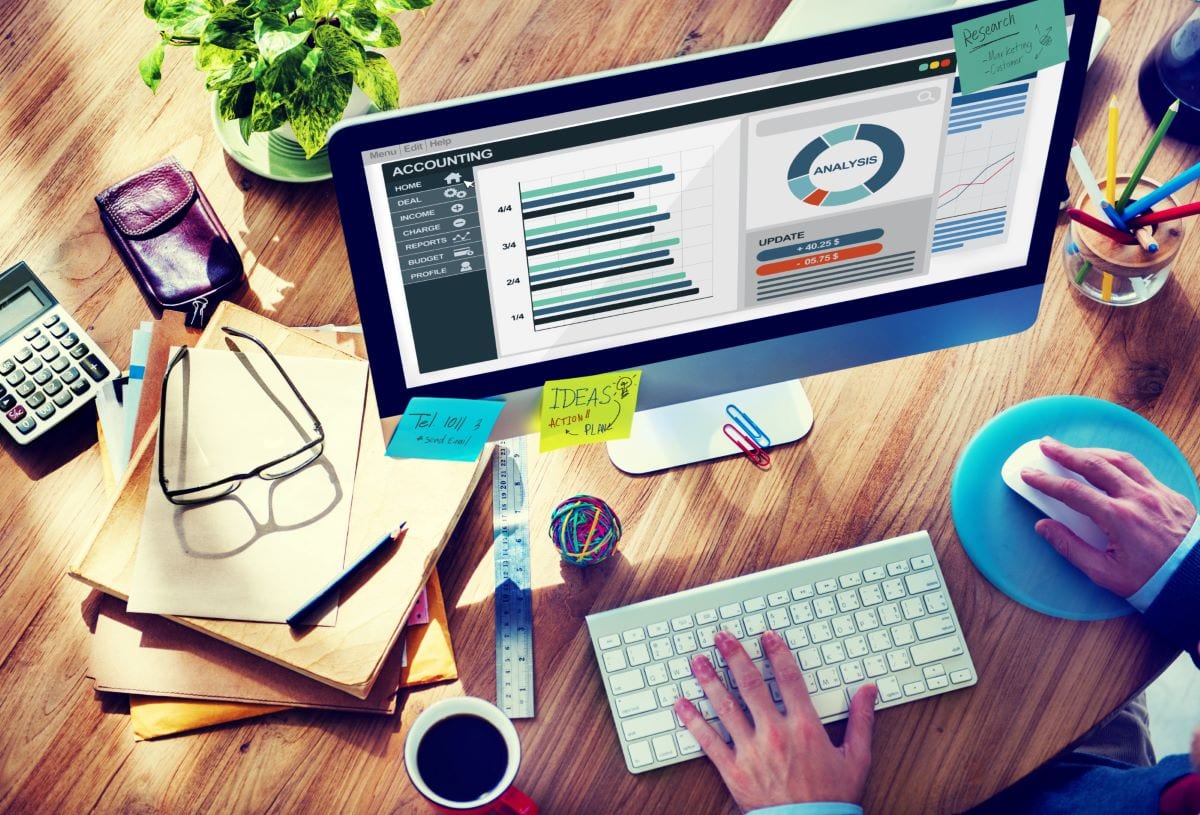

Finance
How To File Receipts For Small Business
Published: November 25, 2023
Learn how to efficiently file receipts for your small business with our helpful finance tips. Streamline your financial organization and stay on top of your expenses.
(Many of the links in this article redirect to a specific reviewed product. Your purchase of these products through affiliate links helps to generate commission for LiveWell, at no extra cost. Learn more)
Table of Contents
- Introduction
- Organizing Receipts
- Setting Up a Filing System
- Categorizing Receipts
- Labeling Receipts
- Storing Physical Receipts
- Digital Receipt Management
- Choosing Receipt Management Software
- Scanning and Digitalizing Receipts
- Backing Up Receipts
- Retention and Disposal of Receipts
- Maintaining Compliance with Tax Laws
- Conclusion
Introduction
As a small business owner, keeping track of receipts is an essential part of managing your finances. Properly organizing and filing your receipts not only ensures that you have accurate records of your business expenses but also makes it easier to stay organized and compliant with tax regulations. Whether you’re dealing with physical receipts or digital copies, having a solid system in place will save you time, stress, and potentially even money.
In this article, we will discuss various strategies and best practices for filing receipts for your small business. From setting up a filing system to categorizing and labeling receipts, as well as managing physical and digital copies, we will provide you with the tools and knowledge to streamline your receipt management process.
Proper receipt management not only facilitates easy access to financial information but also minimizes the risk of losing or improperly recording expenses. Additionally, the organization of receipts plays a crucial role during tax season, enabling you to accurately report deductible expenses and potentially maximize your tax savings.
Whether you’re just starting your small business or looking to improve your existing system, this guide will equip you with the necessary steps and tips to effectively file receipts. Let’s dive in and explore the world of receipt management!
Organizing Receipts
Organizing your receipts is the first step in creating an efficient filing system for your small business. Proper organization ensures that you can easily locate and access receipts whenever you need them, whether it’s for tax purposes, expense tracking, or financial analysis. Here are some key tips for organizing your receipts:
Create a dedicated space: Designate a specific area or folder where you will store all your receipts. This could be a filing cabinet, a drawer, or even a folder on your computer.
Sort by date: Arrange your receipts chronologically to make it easier to track expenses over time. This will also help when reconciling receipts with bank statements.
Separate by type: Group receipts together based on the type of expense. For example, separate receipts for office supplies, travel expenses, and client entertainment. This will make it easier to identify and analyze specific expense categories.
Utilize digital tools: Consider using receipt management software or apps to digitize and store receipts electronically. These tools often offer features like automatic expense categorization and search functionality, making it even easier to organize and locate receipts.
Keep a backup: Whether you are storing physical or digital copies of receipts, it’s always important to have a backup. This ensures that you won’t lose valuable financial information in case of damage, theft, or technological failure.
By implementing these organization strategies, you can establish a system that works best for your business and simplifies the process of managing receipts and expenses.
Setting Up a Filing System
Setting up a proper filing system is crucial to efficiently manage your business receipts. It helps you maintain a systematic approach to organizing and accessing your financial records. Here are some steps to consider when setting up a filing system:
Choose a filing method: Decide whether you want to maintain a physical filing system or go digital. Physical filing involves using folders, binders, or filing cabinets, while digital filing involves storing receipts electronically on your computer or cloud-based storage.
Designate categories: Determine the categories that make sense for your business. These categories will depend on the nature of your expenses and could include categories such as office supplies, travel, utilities, and advertising. Create separate folders for each category.
Create subcategories: Within each category, consider creating subcategories to further organize your receipts. For example, within the “office supplies” category, you may have subcategories like printer supplies, stationery, or computer accessories.
Use clear labels: Clearly label your folders or digital folders with descriptive titles so that you can quickly identify the contents.
Establish naming conventions: If you opt for digital filing, develop consistent naming conventions for your receipts. This makes it easier to search for specific receipts based on names, dates, or other relevant information.
Keep track of expense details: Along with filing receipts, it’s essential to record important details such as the date, vendor name, amount, and purpose of the expense. This information will be valuable when reconciling receipts with bank statements or during tax preparation.
Maintain regular maintenance: Dedicate time on a regular basis to sort and file new receipts. This will prevent a backlog of unorganized receipts and ensure your filing system remains up-to-date.
Whether you choose a physical or digital filing system, the key is to establish a consistent and customized method that suits your business needs. By having a structured filing system in place, you can easily locate receipts when needed and maintain a clear overview of your business expenses.
Categorizing Receipts
Categorizing your receipts is an essential step in organizing your business expenses and maintaining accurate financial records. By assigning each receipt to a specific category, you can easily track and analyze your spending patterns. Here are some tips for effectively categorizing your receipts:
Create broad categories: Start by creating broad categories that align with your business’s expense types. Common categories include office supplies, travel, utilities, rent, marketing, and professional services. These categories should cover the major expenses your business incurs.
Be specific: Within each broad category, create more specific subcategories. For example, within the office supplies category, you could have subcategories like stationery, printer ink, and computer equipment. This level of detail will provide a clearer picture of where your money is being spent.
Match categories to your chart of accounts: If you use an accounting software or have a chart of accounts, align your categories with your chart of accounts. This ensures consistency between your expense categorization and your financial statements.
Review expense types regularly: Periodically review your expense categories to ensure they accurately reflect your business’s spending patterns. As your business evolves, you may need to add or modify categories to better track your expenses.
Consider tax implications: Understand which expenses are deductible for tax purposes and ensure you have appropriate categories for these expenses. This will simplify your tax reporting and help maximize your deductions.
Train your team: If you have employees or contractors who also handle business expenses, provide them with guidance on how to categorize receipts. This ensures consistency and maintains the integrity of your expense tracking system.
Use software or apps: Consider using accounting software or expense tracking apps that offer automatic categorization based on keywords or machine learning algorithms. These tools can save you time and reduce the chance of manual errors.
By categorizing your receipts, you gain a better understanding of your business’s spending patterns, which can inform budgeting decisions and help identify areas where cost savings can be achieved. It also simplifies financial reporting and tax preparation, making it easier to stay compliant with regulations and maximize your deductions.
Labeling Receipts
Labeling your receipts is an important step in organizing and quickly identifying specific expenses in your small business. By clearly labeling your receipts, you can easily locate and track transactions, making financial management more efficient. Here are some tips for effectively labeling your receipts:
Include essential information: Make sure your labeled receipts contain crucial details such as the date of the transaction, the vendor’s name or business, the amount spent, and a brief description of the expense. Having this information readily available on the receipt makes it easier to reference and reconcile expenses.
Use consistent labeling conventions: Develop a consistent method for labeling your receipts to ensure uniformity and ease of retrieval. This could include using abbreviations or codes for certain expense categories or using specific keywords to describe the purpose of the transaction.
Make labels legible: Ensure that your labels are clear and easy to read. Use a legible font, and consider using a label maker or printing labels to maintain a professional look.
Consider color-coding: Using color-coding techniques can help visually differentiate between different types of expenses or expense categories. For example, you may use green labels for office supplies and blue labels for travel expenses.
Organize by date or category: Use a consistent system for organizing your labeled receipts. You may choose to sort them chronologically within each category or alphabetically by vendor name. This makes it easier to locate receipts when needed.
Utilize technology: If you prefer digital receipts, there are various apps and software that allow you to add digital labels to your receipts. Take advantage of these tools to keep your electronic receipts organized and searchable.
Archive or file labeled receipts: Once you have labeled your receipts, store them in an appropriate location based on your filing system. This could be a physical folder or a digital folder on your computer or cloud storage platform.
By effectively labeling your receipts, you can quickly and efficiently locate specific expenses when performing financial analysis, tax reporting, or budget reviews. Consistent and clear labeling not only saves you time but also provides a comprehensive overview of your business’s financial transactions.
Storing Physical Receipts
While digital receipts are becoming more prevalent, many small businesses still receive physical paper receipts. It’s important to establish a proper storage system to keep your physical receipts organized and accessible. Here are some tips for storing physical receipts:
Use a filing cabinet or folder: Invest in a filing cabinet or folder specifically designated for storing your physical receipts. This will provide a secure and organized space for keeping your receipts in one place.
Sort and categorize: Arrange your physical receipts in chronological order and categorize them based on expense types or relevant projects. This will streamline the retrieval process when you need to reference specific receipts later on.
Consider using envelopes or plastic sleeves: To prevent damage or loss, place individual receipts in envelopes or plastic sleeves before storing them in the filing cabinet or folder. This adds an extra layer of protection against wear and tear.
Label folders or dividers: If you store receipts in folders or use dividers within a filing cabinet, label them clearly to indicate the categories or time ranges they contain. This will make it easier to locate receipts within the filing system.
Secure and protect: Ensure that your physical storage area is secure to safeguard your receipts from theft, fire, or water damage. Consider using a locked filing cabinet or storing important receipts in a fireproof box.
Back up receipts: Create backups of your physical receipts by scanning or taking clear photos of them. This will serve as a digital copy in case of any unfortunate events that may damage or destroy the physical receipts.
Retain receipts for the required period: Familiarize yourself with the regulations or laws regarding receipt retention for your industry or country. Generally, it is recommended to keep receipts for several years for tax auditing purposes.
Regularly review and purge: Set aside time periodically to review your physical receipts and remove any that are no longer needed. This will help prevent unnecessary clutter and make your filing system more efficient.
By appropriately storing your physical receipts, you’ll have peace of mind knowing that your financial records are organized and protected. This will also help streamline your financial management processes as you’ll be able to quickly access and reference receipts whenever necessary.
Digital Receipt Management
In today’s digital age, managing receipts electronically offers numerous advantages for small businesses. Digital receipt management not only saves physical space but also provides convenience and accessibility. Here are some key considerations and tips for managing your receipts digitally:
Choose the right receipt management software: There are various software options available designed specifically for receipt management. Research and select a platform that aligns with your business needs and offers features such as expense categorization, search functionalities, and integration with accounting systems.
Scan and save receipts: Scan your physical receipts using a scanner or take clear photos with your smartphone. Save these digital copies in a designated folder on your computer or cloud storage platform for easy access and retrieval.
Automate data extraction: Some receipt management software can automatically extract key information from your scanned receipts, such as vendor name, date, and amount. This saves you time and reduces the need for manual data entry.
Organize and categorize: Create folders or tags within your digital receipt management software to categorize your expenses. This allows you to easily sort and locate specific receipts based on expense type or project. Consistency is key to maintaining an organized digital filing system.
Backup your digital receipts: Just like with physical receipts, it’s important to have a backup of your digital receipts. Consider using cloud storage services or an external hard drive to store your digital receipt files securely.
Integrate with accounting software: If you use accounting software, look for receipt management software that offers integration with your accounting platform. This seamless integration can simplify your financial record-keeping process by automatically syncing receipt data with your accounting system.
Regularly review and reconcile: Set aside time to review your digital receipts and reconcile them with your bank statements or accounting software. This ensures accurate tracking of expenses and prevents any discrepancies or errors.
Stay compliant with tax regulations: Check the tax regulations in your jurisdiction to ensure that digital copies of receipts are accepted by tax authorities. Familiarize yourself with the requirements for digital recordkeeping to remain compliant when it comes to tax reporting.
By adopting digital receipt management, you can reduce paper clutter and streamline your record-keeping process. Digital receipts offer convenience, accessibility, and improved organization, saving you time and effort when managing your business’s expenses.
Choosing Receipt Management Software
When it comes to managing your receipts efficiently, choosing the right receipt management software is essential. With numerous options available, it’s important to consider several factors before making a decision. Here are some key considerations when selecting receipt management software:
Features: Look for software that offers features aligned with your business needs. Common features to consider include receipt scanning and capture, automated data extraction, expense categorization, search functionality, integration with accounting software, and reporting capabilities.
User-Friendliness: Consider the user interface and ease of use. The software should have an intuitive and user-friendly design to ensure smooth adoption and efficient usage by you and your team members.
Compatibility: Check if the software is compatible with your current systems and devices. Ensure that it works well on your operating system, whether it’s Windows, macOS, or mobile platforms like iOS and Android.
Security: Data security is of utmost importance. Look for software that offers robust security measures such as encryption, access controls, and regular data backups. This ensures the confidentiality and integrity of your financial records.
Integration: If you use accounting software or other business tools, consider software that seamlessly integrates with these platforms. Integration facilitates the automatic syncing of data, streamlines your workflow, and reduces the need for manual data entry.
Scalability: Evaluate the scalability of the software. Ensure that it can accommodate your growing business needs as your receipt management requirements increase over time. Check if the software offers different pricing plans or options for expanding your storage capacity or adding additional users.
Reviews and Reputation: Read reviews and feedback from other users to understand their experiences with the software. Look for reputable vendors with a track record of providing reliable and responsive customer support.
Pricing: Consider your budget and evaluate the pricing structure of the software. Determine if the features and benefits offered align with the cost. Some software is available on a subscription basis, while others may have a one-time purchase fee or offer a freemium model with limited functionality.
Trial and Demo: Whenever possible, take advantage of free trials or demos offered by the software providers. This allows you to test the software’s functionality firsthand and determine if it meets your specific business needs.
By carefully considering these factors and conducting thorough research, you can select the right receipt management software that aligns with your business requirements and helps streamline your financial management processes.
Scanning and Digitalizing Receipts
Scanning and digitizing your receipts is a key component of efficient receipt management. By converting physical receipts into digital format, you not only save physical storage space but also gain the benefits of easy access, organization, and searchability. Here are some tips for scanning and digitalizing your receipts:
Invest in a scanner: Purchase a scanner that is suitable for your needs, whether it’s a desktop scanner, a portable scanner, or a scanner built into a multi-function printer. Look for a scanner with high-resolution capability to ensure clear and legible digital copies.
Use smartphone apps: Many receipt management apps offer the ability to take clear photos of your receipts using your smartphone camera. These apps often include automatic cropping and image enhancement features to improve the quality of the scanned receipt.
Ensure proper lighting and positioning: When using a scanner or smartphone camera, make sure the receipt is well-lit, without shadows or glare. Position the receipt flat and straight to ensure a clean, readable scan.
Scan immediately after receiving a receipt: Develop a habit of scanning receipts as soon as you receive them. This prevents the accumulation of a large backlog and reduces the risk of losing or misplacing important receipts.
Organize digital copies: Create a dedicated folder on your computer or cloud storage platform to store your digital receipts. Consider creating subfolders or using tags to further categorize and organize your receipts for easier retrieval.
Name files consistently: Establish a consistent naming convention for your digital receipts to make them easily identifiable. Include pertinent information such as the vendor name, date, and a brief description of the expense.
Consider Optical Character Recognition (OCR) technology: OCR technology converts scanned receipts into searchable and editable text. This can be especially useful when searching for specific receipts based on vendor names or amounts spent.
Backup your digital receipts: Just like with any important digital files, it’s crucial to have backups of your digital receipts. Store them in cloud storage or regularly create backups on external hard drives or other storage devices.
Verify the quality and legibility of scans: After scanning receipts, ensure the image quality is clear and easy to read. It’s important to have legible digital copies to avoid any issues with readability or potential audit concerns.
Dispose of physical receipts securely: Once you have scanned and verified the quality of your digital receipts, consider securely disposing of the physical paper receipts to free up space and reduce clutter. Shred or destroy them to protect sensitive information.
By scanning and digitizing your receipts, you can simplify the process of organizing, accessing, and managing your financial records. Digital receipts offer convenience, efficiency, and improved accuracy, making it easier to stay organized and compliant with tax regulations.
Backing Up Receipts
Backing up your receipts is crucial to ensure the safety and accessibility of your financial records. A reliable backup system protects you from potential data loss due to hardware failures, accidental deletion, or other unforeseen events. Here are some tips for backing up your receipts:
Cloud Storage: Utilize cloud storage services, such as Google Drive, Dropbox, or Microsoft OneDrive, to securely store your digital receipts. Cloud storage offers accessibility from anywhere with an internet connection and provides automatic backup functionality.
External Hard Drives: Invest in external hard drives or solid-state drives (SSDs) to create local backups of your digital receipts. Regularly sync your receipts to these devices to ensure redundancy in case of hardware failures or data corruption.
Automatic Backup Software: Consider using backup software that automatically backs up your receipts at scheduled intervals. These tools can save you time and ensure that your receipts are consistently backed up without manual intervention.
Redundancy: Implement a multi-layered backup strategy to ensure multiple copies of your receipts are stored securely. This can involve combining cloud storage with local external hard drives or using multiple cloud storage providers.
Encryption: Prioritize the security of your backups by encrypting your digital receipt files and ensuring that only authorized individuals have access to them. Encryption offers an additional layer of privacy and protection for your financial records.
Version Control: In case of any accidental changes or deletions, consider using a version control system that allows you to revert back to previous versions of your receipt files. This can be especially helpful if you accidentally overwrite or delete a receipt.
Regularly Test Restores: Periodically test your backup system by restoring receipts to ensure that the backups are functioning correctly. This ensures that you can successfully access and restore your receipts when needed.
Off-Site Storage: To protect against physical damage or loss due to disasters like fire or flooding, consider storing physical receipts and local backups in a separate location, such as a safe deposit box or with a trusted third party.
Automated Syncing: Set up automatic syncing between your receipt management software and your backup systems. This ensures that your backups are always up-to-date without manual intervention.
Regular Backup Schedule: Create a backup schedule that suits your needs, whether it’s daily, weekly, or monthly. Consistency is key to ensuring that your receipts are regularly backed up and protected from potential data loss.
By implementing a robust backup system, you can have peace of mind knowing that your receipts are protected and can be restored in case of any unforeseen circumstances. Regularly review and update your backup strategy as your business and receipt management needs evolve.
Retention and Disposal of Receipts
Knowing how long to retain your receipts and when it’s appropriate to dispose of them is essential for organized and compliant financial record-keeping. While it’s important to retain receipts for a certain period of time, keeping unnecessary receipts can lead to clutter and confusion. Here are some guidelines for retention and disposal of receipts:
Retain for tax purposes: It’s generally recommended to retain receipts for at least 3-7 years for tax purposes. This ensures you have the necessary documentation in case of an audit or if you need to reference specific expenses for tax deductions.
Check local regulations: Familiarize yourself with the specific tax laws and regulations in your jurisdiction regarding the retention period for business receipts. Different countries may have different requirements, so it’s important to adhere to the regulations relevant to your location.
Consult with your accountant or tax advisor: If you’re unsure about the appropriate retention period for your receipts, seek advice from your accountant or tax advisor. They can provide guidance based on your specific circumstances and help ensure compliance with the relevant regulations.
Consider the statute of limitations: Keep in mind the statute of limitations on tax audits or legal actions in your jurisdiction. In some cases, retaining receipts for the duration of the statute of limitations may be sufficient.
Dispose of irrelevant receipts: Regularly review your receipts and dispose of any that are no longer needed. Shred or securely destroy physical receipts to protect sensitive information, and permanently delete digital receipts to ensure they cannot be accessed or recovered.
Keep essential receipts: While it’s important to dispose of irrelevant receipts, certain receipts should be retained even after the required retention period. These may include receipts for major purchases, significant business expenses, or items that have warranties or guarantee coverage beyond the retention period.
Consider digitizing: If you have retained physical receipts beyond the required retention period, consider digitizing them before disposing of the physical copies. This allows you to save space while still keeping a digital archive for reference purposes.
Maintain a disposal log: Keep a record of the receipts you dispose of, along with the associated dates. This serves as a documentation trail and helps demonstrate compliance with your disposal practices if required in the future.
Follow privacy regulations: Ensure that you take appropriate measures to protect the privacy and confidentiality of any sensitive information on your receipts, especially when disposing of physical copies or deleting digital files. Compliance with privacy regulations is crucial to protect your customers’ personal data.
Review your storage system regularly: Periodically reassess your storage system and disposal practices to ensure efficiency and compliance. As your business evolves, your record-keeping needs may change, so it’s important to adapt your retention and disposal practices accordingly.
By following these guidelines, you can effectively manage the retention and disposal of receipts in a way that complies with regulations while keeping your financial records well-organized and clutter-free.
Maintaining Compliance with Tax Laws
Compliance with tax laws is essential for any small business and requires diligent record-keeping and adherence to relevant regulations. Maintaining accurate and organized financial records ensures that you can fulfill your tax obligations and avoid potential penalties or audits. Here are some key practices for maintaining compliance with tax laws:
Keep thorough records: Maintain detailed records of all business transactions, including receipts, invoices, bank statements, and expense reports. These records serve as evidence of your business’s financial activities and can support the deductions you claim.
Separate personal and business expenses: Clearly differentiate between personal and business expenses. Use separate bank accounts and credit cards for your business transactions to ensure clean financial records and avoid mixing personal and business expenses.
Understand deductible expenses: Familiarize yourself with the tax laws in your jurisdiction and the deductible expenses applicable to your business. Ensure that you accurately classify and track deductible expenses to claim the maximum tax benefits.
Track mileage accurately: If your business involves frequent travel or use of vehicles, maintain an accurate mileage log. This log helps substantiate your business-related mileage deductions and ensures compliance with tax regulations.
Retain receipts and documentation: Keep receipts and supporting documentation for business expenses, such as invoices, contracts, and agreements. These documents provide proof of your expenses and may be necessary to substantiate deductions or in case of an audit.
Stay updated on tax regulations: Regularly stay informed about changes in tax laws and regulations that may affect your business. Attend seminars, consult with tax professionals, or subscribe to reliable sources to stay up to date with the latest tax-related updates.
Seek professional advice: If you are uncertain about any tax laws or regulations, consult with a tax professional or accountant who can provide guidance specific to your business needs. They can help ensure accurate tax reporting and compliance with applicable laws.
File tax returns on time: Adhere to the deadlines for filing tax returns and paying taxes. Late filings can lead to penalties or interest charges, putting your business at risk of non-compliance.
Consider tax planning strategies: Work with a tax advisor to develop strategies that minimize your tax liability legally. By optimizing deductions, tax credits, and structuring your business appropriately, you can maximize tax efficiency while maintaining compliance.
Retain records for the required period: Keep financial records, including receipts, for the duration required by tax laws in your jurisdiction. This ensures that you can provide supporting documentation if requested during an audit or assessment by tax authorities.
By following these practices, you can maintain compliance with tax laws, effectively manage your business’s financial records, and ensure accurate tax reporting. Staying organized, staying informed, and seeking professional guidance when needed are key to successfully navigating the complexities of tax regulations.
Conclusion
Properly organizing and managing your receipts is a fundamental aspect of running a successful small business. By implementing effective receipt management practices, you can streamline financial record-keeping, stay compliant with tax regulations, and gain valuable insights into your business’s expenses.
In this article, we explored various strategies for effectively filing, organizing, and categorizing your receipts. We discussed the importance of setting up a filing system, labeling receipts, and storing both physical and digital copies securely. We also highlighted the benefits of digital receipt management, including scanning and digitizing receipts, as well as the importance of backing up your digital files to protect against data loss.
We also covered key considerations for selecting receipt management software, such as features, user-friendliness, compatibility, and security. Additionally, we discussed best practices for retention and disposal of receipts, maintaining compliance with tax laws, and seeking professional advice when necessary.
By implementing these receipt management practices, you can improve the accuracy and efficiency of your financial record-keeping, saving you time, reducing stress, and enabling better decision-making for your business. It’s important to remember that each business may have unique needs, so tailor these methods to suit your specific requirements.
Stay organized, stay diligent, and regularly review and update your receipt management processes to ensure ongoing efficiency and compliance. Good receipt management will contribute to your overall financial health, tax readiness, and a smooth operation of your small business.














